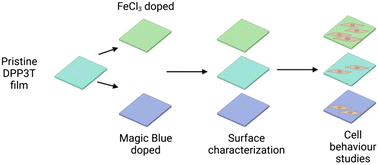Improving the biological interfacing capability of diketopyrrolopyrrole polymers via p-type doping†
Abstract
Polydiketopyrrolopyrrole terthiophene (DPP3T) is an organic semiconducting polymer that has been widely investigated as the active layer within organic electronic devices, such as photovoltaics and bioelectronic sensors. To facilitate interfacing between biological systems and organic semiconductors it is crucial to tune the material properties to support not only cell adhesion, but also proliferation and growth. Herein, we highlight the potential of molecular doping to judiciously modulate the surface properties of DPP3T and investigate the effects on Schwann cell behaviour on the surface. By using p-type dopants FeCl3 and Magic Blue, we successfully alter the topography of DPP3T thin films, which in turn alters cell behaviour of a Schwann cell line on the surfaces of the films over the course of 48 hours. Cell numbers are significantly increased within both DPP3T doped films, as well as cells possessing larger, more spread out morphology indicated by cell size and shape analysis. Furthermore, the viability of the Schwann cells seeded on the surfaces of the films was not significantly lowered. The use of dopants for influencing cell behaviour on semiconducting polymers holds great promise for improving the cell-device interface, potentially allowing better integration of cells and devices at the initial time of introduction to a biological environment.

- This article is part of the themed collection: Journal of Materials Chemistry C Emerging Investigators


 Please wait while we load your content...
Please wait while we load your content...